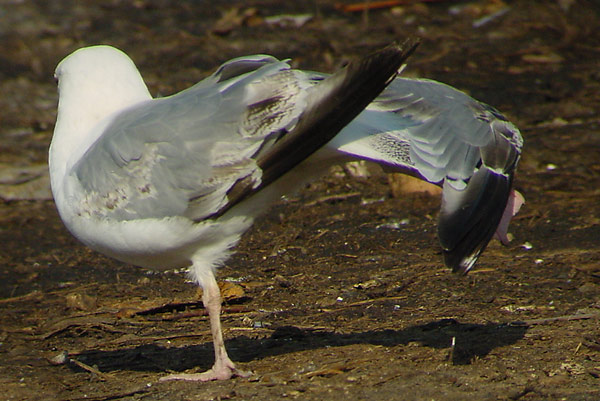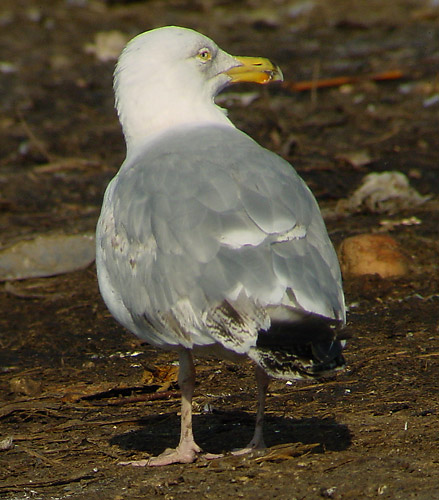 Herring
Gull - Zilvermeeuw (argentatus & argenteus): sub-adult July
Herring
Gull - Zilvermeeuw (argentatus & argenteus): sub-adult July
(last update: 24 maart 2004)
Home
Links
to Gull Sites
Gull Taxa
Gull Topography
Grey & Colour Charts
Locations in NW Europe
Summaries of Articles
About ORG
@
(3 images) Herring Gull 4cy (argentatus), July 14 2003, Tampere, Finland (61.31N, 23.43E).

4cy argentatus with open
wings, showing the pattern in old third generation outer primaries and
fourth generation inner primaries.
The complete moult has started with many wing-coverts and the inner primaries recently
moulted. The outer primaries P8-P10 are old and still third generation with a
diffuse mirror on P10. The inner four primaries are fully
grown fourth generation flight-feathers, with with P5 at the length of P3
and the tip of P6 just visible. P5 has slightly more black than in most
full adult argentatus birds at Tampere, and resembles the pattern
of full adult argenteus. The old tail-feathers and old secondaries show
many dark markings the tail somewhat resembles 3cy birds (see also this ringed
bird). Moult in the
wing-coverts is obvious with the median, innermost and outer lower lesser coverts,
the upper tertials and inner greater coverts replaced; they appear plain
grey. The central and outer greater coverts are missing, exposing the base
of the secondaries underneath.
Rectrices and secondaries are not included in the complete moult yet and
are all old third generation. The colour of legs and iris is much
adult-like, the bill is still immature with a complete band.

From June to December, sub-adult argentatus undergo a complete moult resulting in so-called "winter plumage". From June onwards, the new plain grey wing-coverts are moulted in, starting with the outermost median coverts and followed by the inner medians, the inner greaters, and the rest of median and lower lesser coverts. By August, the first neat streaks can be found on the crown and hind-neck. After the complete moult is finished by late autumn, the head will show extensive 'winter streaking' in argenteus, often neat fine streaking in sub-adult argentatus. Also, by the end of the complete moult, the scapulars, mantle and all the wing-coverts will be replaced and near-adult argentatus can hardly be distinguished from full adult plumage (except more black on the bill and often the dark centres in the outer greater primary coverts).
During the summer, the primaries are replaced. In argentatus, the last outer primary P10 will be fully grown by early December, slightly later than in West-European argenteus. However, first data from Tampere, Finland indicate that 3cy argentatus from this region are not delayed in primary moult compared to argenteus.
Adult northern argentatus show a
different pattern in the outer primaries, compared to argenteus. In
argentatus, especially from northern Scandinavia, the black markings
on P5 are very limited and, if black on P5 is present, this black often
has diffuse edges. More often, these black sub-terminal markings are
completely lacking on P5. In Baltic argentatus populations,
normally black on P5 is confined to the outer-web, with sharply defined
edges.
Argenteus normally has a black sub-terminal band on the top of P10,
dividing the tip from the mirror. If the black sub-terminal band on P10 is
broken, the outer-web of P10 still shows black marking. Argentatus
normally completely lacks sub-terminal markings, also on the outer-web of
P10. Some argentatus completely lack black on the edge of the
inner-web, creating a so-called "thayeri pattern".
